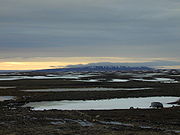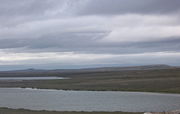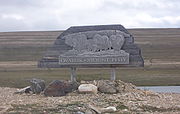
Ovayok Territorial Park, Nunavut
Encyclopedia

Cambridge Bay, Nunavut
Cambridge Bay, named for Prince Adolphus, Duke of Cambridge, is a hamlet located in the Kitikmeot Region of Nunavut, Canada...
, Kitikmeot
Kitikmeot Region, Nunavut
Kitikmeot Region is an administrative region of Nunavut, Canada. It consists of the southern and eastern parts of Victoria Island with the adjacent part of the mainland as far as the Boothia Peninsula, together with King William Island and the southern portion of Prince of Wales Island...
, Nunavut
Nunavut
Nunavut is the largest and newest federal territory of Canada; it was separated officially from the Northwest Territories on April 1, 1999, via the Nunavut Act and the Nunavut Land Claims Agreement Act, though the actual boundaries had been established in 1993...
, Canada
Canada
Canada is a North American country consisting of ten provinces and three territories. Located in the northern part of the continent, it extends from the Atlantic Ocean in the east to the Pacific Ocean in the west, and northward into the Arctic Ocean...
. The park is relatively small and covers an area of approximately 16 km² (6.2 sq mi). The park can be accessed by vehicle from the community as a gravel road runs directly to it.
The park has a wide variety of wildlife with muskox being predominant; there are also barren-ground caribou
Barren-ground Caribou
Barren-ground Caribou is a subspecies of the caribou that is found mainly in the Canadian territories Nunavut and the Northwest Territories and western Greenland. It sometimes includes the similar porcupine caribou, in which case the barren-ground caribou also is found in Alaska...
, arctic hare
Arctic Hare
The arctic hare , or polar rabbit is a species of hare which is adapted largely to polar and mountainous habitats. The arctic hare survives with a thick coat of fur and usually digs holes under the ground or snow to keep warm and sleep...
, arctic fox
Arctic fox
The arctic fox , also known as the white fox, polar fox or snow fox, is a small fox native to Arctic regions of the Northern Hemisphere and is common throughout the Arctic tundra biome. The Greek word alopex, means a fox and Vulpes is the Latin version...
, and North American brown lemming
North American Brown Lemming
The North American brown lemming, Lemmus trimucronatus, is a small North American lemming. Originally called the Siberian Brown Lemming Lemmus sibiricus it was later decided that they formed two distinct species....
s. There are several lakes within the park and most contain Arctic char
Arctic char
Arctic char or Arctic charr is both a freshwater and saltwater fish in the Salmonidae family, native to Arctic, sub-Arctic and alpine lakes and coastal waters. No other freshwater fish is found as far north. It is the only species of fish in Lake Hazen, on Ellesmere Island in the Canadian Arctic...
and lake trout
Lake trout
Lake trout is a freshwater char living mainly in lakes in northern North America. Other names for it include mackinaw, lake char , touladi, togue, and grey trout. In Lake Superior, they can also be variously known as siscowet, paperbellies and leans...
. Birds include Arctic tern
Arctic Tern
The Arctic Tern is a seabird of the tern family Sternidae. This bird has a circumpolar breeding distribution covering the Arctic and sub-Arctic regions of Europe, Asia, and North America...
s, ptarmigan
Willow Grouse
The Willow Ptarmigan , also known as the Willow Grouse, is a bird of the grouse subfamily. It is a sedentary species, breeding in birch and other forests and moorlands in the tundra of Scandinavia, Siberia, Alaska, northern Canada, in particular the province of Newfoundland and Labrador...
, Canada geese
Canada Goose
The Canada Goose is a wild goose belonging to the genus Branta, which is native to arctic and temperate regions of North America, having a black head and neck, white patches on the face, and a brownish-gray body....
, snowy owl
Snowy Owl
The Snowy Owl is a large owl of the typical owl family Strigidae. The Snowy Owl was first classified in 1758 by Carolus Linnaeus, the Swedish naturalist who developed binomial nomenclature to classify and organize plants and animals. The bird is also known in North America as the Arctic Owl, Great...
s and the common raven
Common Raven
The Common Raven , also known as the Northern Raven, is a large, all-black passerine bird. Found across the northern hemisphere, it is the most widely distributed of all corvids...
.
There are several archaeological
Archaeology
Archaeology, or archeology , is the study of human society, primarily through the recovery and analysis of the material culture and environmental data that they have left behind, which includes artifacts, architecture, biofacts and cultural landscapes...
sites within the park and these include tent rings and food caches. Thule
Thule people
The Thule or proto-Inuit were the ancestors of all modern Inuit. They developed in coastal Alaska by AD 1000 and expanded eastwards across Canada, reaching Greenland by the 13th century. In the process, they replaced people of the earlier Dorset culture that had previously inhabited the region...
and Paleo-Eskimo
Paleo-Eskimo
The Paleo-Eskimo were the peoples who inhabited the Arctic region from Chukotka in present-day Russia across North America to Greenland prior to the rise of the modern Inuit and/or Eskimo and related cultures...
camp sites and artifacts has also been found nearby, suggesting that the area has been in use for at least a 1,000 years.
The predominant feature of the park is the large esker
Esker
An esker is a long winding ridge of stratified sand and gravel, examples of which occur in glaciated and formerly glaciated regions of Europe and North America...
known as Ovayok (Mount Pelly) that rises to approximately 183 m (600.4 ft). Behind this are two more eskers called Inuuhuktu (Baby Pelly) and Amaaqtuq (Lady Pelly).
Inuit
Inuit
The Inuit are a group of culturally similar indigenous peoples inhabiting the Arctic regions of Canada , Denmark , Russia and the United States . Inuit means “the people” in the Inuktitut language...
legend says that the three hills are a family of starving giant
Giant (mythology)
The mythology and legends of many different cultures include monsters of human appearance but prodigious size and strength. "Giant" is the English word commonly used for such beings, derived from one of the most famed examples: the gigantes of Greek mythology.In various Indo-European mythologies,...
s. They were crossing Victoria Island looking for food and the father, Ovayok, died first. Next the son, Inuuhuktu (English
English language
English is a West Germanic language that arose in the Anglo-Saxon kingdoms of England and spread into what was to become south-east Scotland under the influence of the Anglian medieval kingdom of Northumbria...
; "son"), died and was followed by the mother, Amaaqtuq (English; "packing baby", see amauti
Amauti
The amauti is the traditional eastern Arctic Inuit parka designed to carry a child in the same garment as the parent so that the child is warm and safe from frostbite, wind and cold. The amauti can be made from a variety of materials including sealskin, caribou skin or duffle with a windproof...
), who was carrying her baby.



